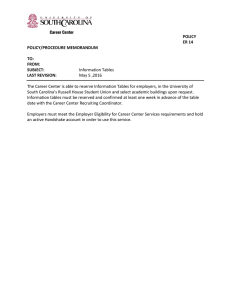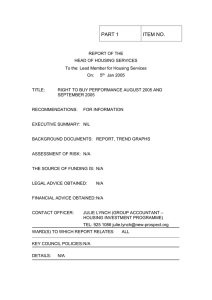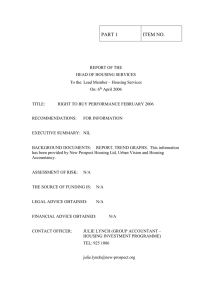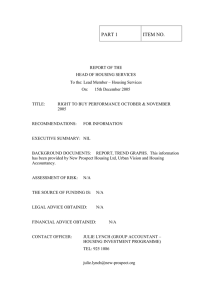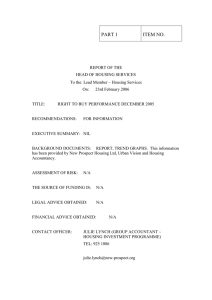A new way of looking at sickness absence
advertisement
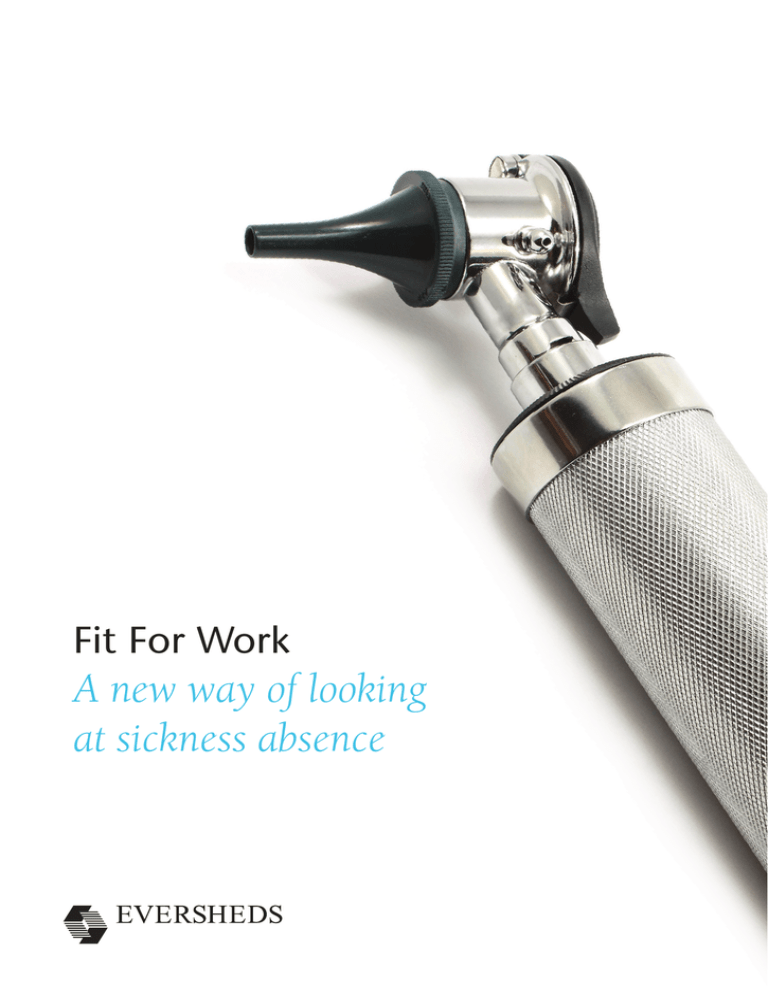
Fit For Work A new way of looking at sickness absence FIT FOR WORK: A NEW WAY OF LOOKING AT SICKNESS ABSENCE 2014 figures suggest that workers in the UK take in excess of 130 million days’ sickness absence annually and working-age ill health costs the national economy £100 billion each year. As many as 960,000 employees are understood to be on sick leave for a month or more each year, with nearly 1/3 of those dropping out of employment altogether. And yet, it is well-known that being in work is generally good for our health, from personal morale and income, to wider social impacts. In contrast, sickness absence commonly presents raised costs and productivity issues for employers, financial and psychological struggles for the individuals affected and their families, not to mention a strain upon the State. A Government-commissioned report by Dame Carol Black and David Frost in 2011 (Health at work – an independent review of sickness absence) led to a comprehensive review of sickness absence in the UK, from absence statistics, causes and effects. Several themes were identified including that, after four weeks’ absence, many employees slip into long-term absence, despite evidence that early interventions are highly effective in reversing this trend. In addition, feedback from employers suggested many were in need of independent, bespoke advice, especially those who do not have occupational health support or readyaccess to professional advice. Amongst the recommendations of the 2011 review were: • A state-funded independent assessment and advisory service, to support return to work • Revised Fit Note guidance • Tax relief for employers on medical treatments or vocational rehabilitation • Retention of tax relief on Employee Assistance Programmes • Abolition of the Percentage Threshold Scheme • Abolition of Statutory Sick Pay record-keeping requirements • A new job-brokering service to help long-term sick employees find new work 1 FIT FOR WORK: A NEW WAY OF LOOKING AT SICKNESS ABSENCE Fit for Work In response to the 2011 review’s findings, the Government has set up Fit for Work, a new service providing free occupational health advice and support for employees, employers and GPs. The specific objective of Fit for Work is to help people with a health condition stay in or return to work, through a free telephone and on-line advice service but also, an independent health assessment and follow-up after just 4 consecutive weeks’ sickness absence. Assessment will lead to a Return to Work Plan and series of recommendations for employers to facilitate the employee’s return to work. The helpline became operational on 15 December 2014 and was followed by the gradual roll-out of the assessment aspect of the service. The Government’s aim is that, aside from the important role that Fit for Work will play in helping employees back to work, by providing employers with early access to advice on how to support their employees to stay in work, it will also have a vital preventative role, reducing the likelihood of absence. It will additionally encourage employees themselves to focus on their circumstances and future. Tax incentive for employers The 2011 review additionally recommended that expenditure by employers on medical treatment and vocational rehabilitation to keep sick employees in work or facilitate their return – expenses which would ordinarily be subject to income tax and national insurance contribution – should attract tax relief. From 1 January 2015 a tax exemption will apply to qualifying employer-expenditure, including treatment that is: • recommended in writing by Fit for Work, an employer Occupational Health adviser or other registered medical practitioner; • aimed at helping an employee return to work after a period of at least 28 consecutive days’ absence (or expected absence) due to injury or ill-health. The exemption will not apply unless the employee has been assessed as unfit for work for at least 28 consecutive days or has been off sick for that period. The maximum permitted exemption per employee in any tax year is £500. 2 FIT FOR WORK: A NEW WAY OF LOOKING AT SICKNESS ABSENCE What employers need to consider How will Fit for Work operate in practice? Employers need to be aware of the changes which Fit for Work is likely to bring about to their current absence management practices. For some employers, the first they will know of an employee referral to Fit for Work may be upon receipt of a Return to Work Plan. A case study is set out below illustrating how Fit for Work might sit with current absence management practice but the Service has three principal roles: Appointment of Case Manager • Assessment – to identify barriers to the individual returning to work; Initial telephone assessment (aim is within 2 days of referral) In light of the potential involvement of Fit for Work in employee sickness absenteeism, employers will need to consider their sickness absence policies and whether they wish to impose requirements upon employees as regards co-operation in the assessment process, highlighting any effects of failure to do so. • Case Management; and Particular issues to consider include: • Line managers will generally be the first point of contact for Fit for Work. Are your managers equipped to respond to ‘Return to Work’ recommendations they receive. Is training needed? Will you nominate one person as a central point of contact and communicate this to employees? • Understanding whether there might be consequences if recommendations are not acted upon. Co-operation with Fit for Work is entirely voluntary but there may be legal implications if dismissal is later contemplated or reasonable adjustment fails to be made. • Advice – accessible to employers, employees and GPs by phone or online. Referral to Fit for Work is described as the “default position” for GPs. Whilst referral is at GP discretion, therefore, it is expected that the GP will ask the employee to consent to a referral as soon as it appears he or she is likely to be unfit for at least 4 weeks unless one of the very limited exceptions applies (see below). The Government hopes that the referral process will take no more than 2 weeks. If that hope is fulfilled then it is likely that an employer will typically receive a Return to Work Plan no later than 6 weeks after the start of the absence. Alternatively, then so long as the employee has been absent for at least 4 weeks the employer may seek referral for employee assessment. As with a GP referral, this will only be able to proceed if Fit for Work agrees the individual is suitable and eligible to participate in the scheme. • Revising policies and procedures able to accommodate this change in approach. Three important caveats apply: • Considering how (if at all), Fit for Work might impact upon existing in-house Occupational Health resource. Are your employees aware of such resource? • The 4 weeks absence must be consecutive; intermittent absences of fewer than 4 weeks will not count, even if they would do so if added together • Participation is voluntary for all concerned • Not every absent employee will be eligible – Fit for Work aims to focus upon those employees who can realistically be helped within a 3 month period. Those with prolonged or more complex health issues are unlikely to fall within that category. Also, only one referral is permitted per employee in any 12 month period. This means that if the employee has a second period of absence, for whatever reason, neither the employee nor the employer can obtain a Return to Work Plan from Fit for Work. Presumably they can however still ask for advice via the helpline –though such difficult cases may be beyond the scope or expertise of the helpline advisers. The assessment process is likely to involve the following stages: GP referral after 4 weeks’ sickness absence Further telephone assessment (aim is within 2 days of initial assessment) Face to face assessment (if needed – either initial or further. Aim is within 5 days of phone assessment ) Return to Work Plan sent to the employee (aim is within 2 working days of assessment) Fit for Work will send a Return to Work Plan to the GP and/or employer (providing employee consents) Progress review by Case Manager The process will end when either: • The employee returns to work (including a return on a phased basis) • Fit for Work can offer no further assistance • A return to work has not proved possible after 3 months. The Return to Work Plan will not only identify the steps which the Fit for Work adviser deems appropriate to facilitate the employee’s return to work, but will set out a timeframe within which that is expected to happen. Once an employee has been referred to Fit for Work for assessment, Fit for Work may assume control over the issuing of future Fit Notes. In the normal course of events, once the employer receives a Return to Work Plan, they should assume they do not require further Fit Notes whilst the plan is operational. If the employee declines to disclose the Return to Work Plan to his or her employer, the Fit for Work adviser will refer the individual back to the GP who will then resume responsibility for the issuing of Fit Notes. 3 FIT FOR WORK: A NEW WAY OF LOOKING AT SICKNESS ABSENCE FIT FOR WORK: A NEW WAY OF LOOKING AT SICKNESS ABSENCE Legal issues for employers Disability discrimination DISCRIMINATION DISMISSAL BREACH OF CONTRACT DATA PROTECTION HOLIDAY PAY Employers are required to make reasonable adjustments in relation to any employee who comes within the legal definition of a “disabled person”. Some but not all sick employees will fit this definition. Therefore, any recommendations for adjustments to equipment, work duties and policies and rules which are made in the Return to Work Plan should be given serious consideration since a tribunal will probably start from the assumption that such recommendation adjustments are “reasonable” ones for the employer to make. Even if the employee is not “disabled”, if the employer declines to make an adjustment the consequence may be that the employee cannot return to work and is ultimately dismissed. Such a dismissal will not be fair if it would have been reasonable to make the adjustment. So once again the recommendations in the Return to Work Plan are important even if the employee is not technically within the definition of a disabled person. Employers must also take care not to be unreasonably influenced by third party advisers, such as Occupational Health professionals. Employers have been reminded recently that they cannot follow such advice blindly, for example to claim a lack of knowledge of disability, but must form their own judgement on all the facts available (Gallop -v- Newport City Council, 2014). When is an adjustment “reasonable”? Employers are obliged legally to make reasonable adjustments to counter disadvantage from disability. What is “reasonable” in this context will vary according to the circumstances and can only be determined definitively by a Tribunal. Factors to be taken into account include whether the adjustment would have redressed disadvantage to the employee resulting from disability, the financial resources of the employer in terms of funding the adjustment and any disruption the adjustment might cause for the employer. It is now clear that what is reasonable extends beyond workplace adjustments, to steps such as funding private psychiatric counselling, if they will help an employee deal with the pressures of work (Croft Vets Limited -v- Butcher 2013). Fit for Work’s focus is upon overcoming obstacles to a return to work, whether or not health-related. Its recommendations may well include counselling, therefore. Although employers will not necessarily be obliged to act upon all recommendations, they should nonetheless approach them with caution as potentially reasonable adjustments. When is it reasonable to dismiss for long-term sickness absence? Clearly, not all employees who are absent due to ill-health will be capable of returning to work or at least will not be able to do so before it is reasonable for the employer to decide that it cannot wait any longer. Fit for Work will have a role, as part of its case management function, to identify this and, if appropriate, to refer the employee to a new internet job-matching service. For employers, the point at which dismissal becomes a relevant consideration will vary but the courts have identified three important themes: • Can the employer be expected to wait any longer? • Employers should consult with the employee and take their views into account; • Employers should take steps to discover the employee’s medical condition and likely prognosis. Length of service is also a relevant factor. (BS -v Dundee County Council, 2013) PERSONAL INJURY/HEALTH & SAFETY As employers will be all too aware, addressing sickness absence can introduce an array of legal issues. These will be just as relevant in the context of Fit for Work, from discrimination to breach of contract, pay queries and matters of health and safety. Also, decisions over dismissal (if applicable) bring with them a need for fairness and fair process, as well as reflection upon whether the contract has been frustrated or whether permanent health insurance protection might be affected. 4 5 FIT FOR WORK: A NEW WAY OF LOOKING AT SICKNESS ABSENCE Absence management example scenario under Fit for Work FIT FOR WORK: A NEW WAY OF LOOKING AT SICKNESS ABSENCE Q:Does Julie qualify for referral? Yes No Q: How long might referral take? 2 days • This is Julie 2 weeks • She works as a Cashier at National Bank 6 months • Recently, Julie has felt everything is going wrong. She has loans she is struggling to pay, resulting in violent arguments with her husband and she is now exhibiting symptoms of stress Q: Does Julie have to comply with it? • She has been off work for 2 weeks but has now made an appointment to see her GP again • Julie’s manager, Sue, is worried • Julie had been arriving late for work and when there, had been forgetful and distracted. Her interaction with customers had also been poor • Julie has now been on sick leave for 2 weeks with “stress”, which presents a staffing problem • Sue wants to be sympathetic but also wants to know if there is anything she can do to facilitate Julie’s return. She calls the Fit for Work helpline • The adviser recommends that Sue talks to Julie, to see if she is prepared to discuss the causes of her stress (in confidence) and to consider whether there is anything the Bank might do to facilitate her return to work GP notes Fit Note Employer records How long will it take to produce a Return to Work Plan? 2 days Yes 2 weeks No 6 months A: YES, Julie appears to qualify for referral. Unless one of the limited exceptions applies, as outlined above (such as the GP perceives Julie could not be helped to return to work in the next 3 months or she has already been referred to Fit for Work in the last 12 months), providing Julie consents, she would appear to qualify for assessment and support from Fit for Work. (One exception might be if her GP diagnoses a condition which, in his or her view, cannot be helped within the 3 month time frame applicable to Fit for Work. It would then be an option for the GP to delay referral until such time as Fit for Work might be in a position to help. GPs hold ultimate discretion, however. • An appointment is made by Fit for Work for Julie to speak to an assessment officer by phone • Julie also mentions that she does not want her employer to know that she has debt problems • Julie’s GP identifies that she is suffering from various stress-related symptoms (loss of sleep, anxiety, loss of concentration) • During the call, she tells the adviser all about her issues at home, her symptoms and that she has started having panic attacks • Time has moved on and Julie has now been absent for 4 weeks Q: What medical and other information will the Fit for Work Adviser see prior to the call? • The adviser explains they will draw up a Return to Work Plan. A: FIT NOTES ONLY. A criticism of Fit for Work amongst employers has been that the advisers will know next to nothing of the employee’s medical history. In terms of the objectives of the service, that is deliberate. It is vital to distinguish a health assessment in the clinical sense from what Fit for Work is about, which is an holistic appraisal of what is preventing an employee from returning to work. However, once Fit for Work has made contact with the employee then, providing the employee consents, the adviser may choose to contact the GP and/or employer for further information before proceeding. • The Fit for Work adviser sends Julie a Return to Work Plan, confirming her continued absence for stress but suggesting interventions which might facilitate her return to work: – she has an informal meeting with Sue asap; – a return to back office duties in 2 weeks; – a phased return to cash desk duties in 1 month; –funding/ time off for Cognitive Behavioural Therapy (CBT); – funding/ time-off for debt counselling; – time-off to attend Marriage Guidance • He provides a Fit Note for a further 2 weeks, but recommends referral for a Fit For Work assessment 6 7 FIT FOR WORK: A NEW WAY OF LOOKING AT SICKNESS ABSENCE FIT FOR WORK: A NEW WAY OF LOOKING AT SICKNESS ABSENCE Q: Must Julie allow National Bank to see the Return to Work Plan? Q: Does Sue have to speak with the Case Manager? Q: Can the Case Manager offer advice upon disciplinary action? Q: On receiving the revised Return to Work Plan, what are National Bank’s options? Yes Yes Yes Must wait 6 months No No No Commence dismissal procedure Continue to provide support/ liaise with Julie Q: Is National Bank obliged to accept all/ any of the recommendations in the Return to Work Plan? Yes No A: NO. Julie has control over what (if anything) the employer and/ or the GP, sees. She could, for example, ask for a redacted Return to Work Plan, if she isn’t comfortable with her employer seeing the whole thing and could request a different version again for her GP. • Julie permits a redacted version of the Return to Work Plan (omitting the reference to debt-counselling) to be sent to National Bank Q: Is National Bank obliged to fund CBT? Yes Yes No No A: NO. See previous answer although, in principle, many employers might wish at least to have the conversation. Even so, employers need to be confident in their managers’ ability to discuss such issues with an adviser from Fit for Work. • The Case Manager speaks to Sue and explains Julie’s anxiety • The Case Manager also explains the CBT may attract tax exemptions • 2 weeks later she receives an appointment for a telephone review with her Fit for Work Case Manager • Julie tells the Case Manager that she met with Sue in accordance with the Return to Work Plan, but the meeting didn’t go well as National Bank don’t want to fund CBT • Julie agrees to the Case Manager contacting Sue Q: Can the Case Manager offer advice upon disability? • Sue is frustrated that Julie has avoided her calls and is struggling with staff cover. She is thinking about disciplinary action • What Sue really wants to know is whether Julie might have a disability which could impact on her next steps. Q: Could Julie rely on a failure to comply with the Return to Work Plan to support a tribunal claim against National Bank? Yes No A: NO. It is not the function of Fit for Work to involve itself in advice on disciplinary issues nor legal issues such as defining disability and its advisers will not be qualified to do so. In either case, employers must reach their own conclusions about disciplinary action and disability, based on all the evidence available. However, the final question is slightly less straight forward. It remains to be seen quite what weight employment tribunals will attach to Return to Work Plans in the context of a claim. Whilst a failure to comply with a reasonable recommendation of Fit for Work is not automatically a failure to effect a reasonable adjustment, it seems highly likely this will at least be referred to as a persuasive part of the overall evidence of alleged employer failings. • Julie speaks to Sue who allays her fears regarding a return to work Q: Would it make a difference if the advice to Julie was that she should not return to a public-facing role? Yes No A: ALL OF THE ABOVE are options for the Bank, depending upon the circumstances and the ability to cover Julie’s absence, etc. It could commence a dismissal procedure but would need to be seen to act reasonably and fairly. In any event, a fair dismissal procedure would expect the Bank to liaise with Julie and consider possible alternatives to dismissal before deciding to dismiss. If Julie’s public-facing role is the primary issue, whether or not the Bank can reasonably accommodate a move will depend upon the size and resources of the Bank and whether there any reasonable alternative roles for Julie. What if.. • Julie had omitted to tell her GP or the Fit for Work adviser that National Bank has its own in-house Occupational Health team? • As soon as Sue received the Return to Work Plan, she referred it to her in-house advisers for review? • The in-house team is concerned, based on previous periods of absence, that Julie may be suffering from depression and it disagrees with the Return to Work Plan (see next page) • Sadly, “out of the blue” the day before her agreed return, Julie receives a solicitors letter regarding a divorce • Julie goes to pieces and has a severe anxiety attack. Her GP tells her she should take at least 6 months off work and agrees to speak with the Case Manager • The Case Manager suggests a revised Return to Work Plan 8 9 FIT FOR WORK: A NEW WAY OF LOOKING AT SICKNESS ABSENCE Q: Which recommendations take precedence, those expressed in: Return to Work Plan? OR report prepared by in-house Occupational Health advisers? FIT FOR WORK: A NEW WAY OF LOOKING AT SICKNESS ABSENCE A: Ultimately, the employer will need to reach its own decisions, based on all the evidence. Practical reality, however, is that the inhouse advisers are likely to have greater knowledge. Also, Fit for Work is committed to working with in-house teams so it is unlikely they would oppose that team’s view and would largely delegate the Return to Work Plans to them. Fit for Work contact details Does your organisation need help to get ready? England and Wales www.fitforwork.org 0800 032 6235 The Government is rolling out a more pro-active approach to managing sickness absence through a new service, “Fit for Work”. Welsh Language Line www.fitforwork.org 0800 032 6233 The specific objective of Fit for Work is to help people with a health condition stay in or return to work, support being provided by a telephone and on-line advice service. But Fit for Work will also offer employees an independent health assessment after just 4 weeks’ of sickness absence. These assessments will result in a Return to Work Plan, likely to include a series of recommendations for employers, aimed at facilitating the employee’s return to work. Scotland www.fitforworkscotland.scot 0800 019 2211 We can assist your organisation by: Preparing your managers for this change and ensure they are aware of its implications? Equip your managers with the skills to address ‘return to work’ recommendations received from Fit for Work without risking discrimination Ensure policies and procedures able to accommodate this change in approach? Having been involved in early discussions about the new regime with the Department for Work and Pensions and co-presented a national series of briefing sessions with them, we can offer your organisation training and advice on how the new scheme will affect your approach to sickness absence and the potential pitfalls. If you want to learn more, please contact Naeema Choudry, Partner, on 0845 497 8283 or via naeemachoudry@eversheds.com or Sally Isaacs, Principal Associate, 0845 498 7743 or via sallyisaacs@ eversheds.com. 10 11 FIT FOR WORK: A NEW WAY OF LOOKING AT SICKNESS ABSENCE Notes 12 www.eversheds.com ©Eversheds LLP 2015. Eversheds LLP is a limited liability partnership. ECEN.1036 01.15

